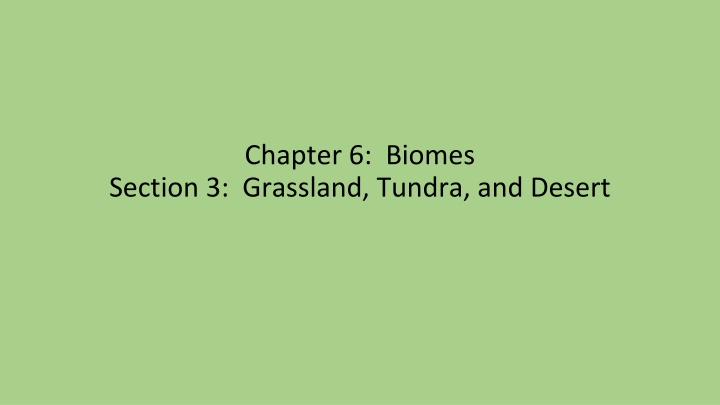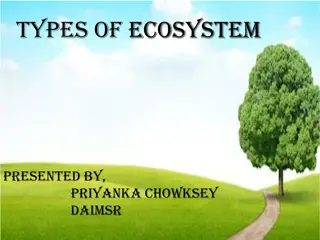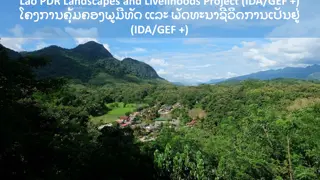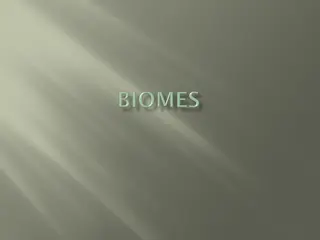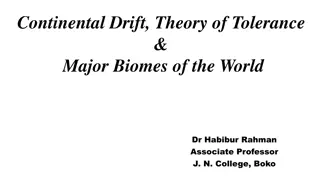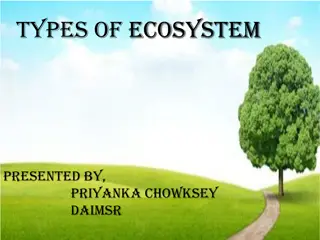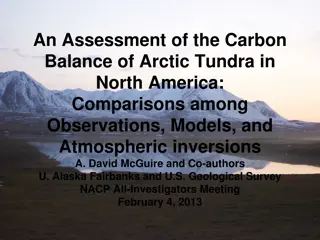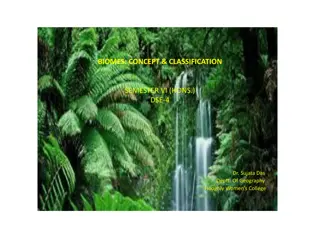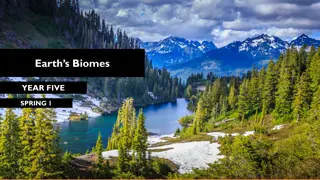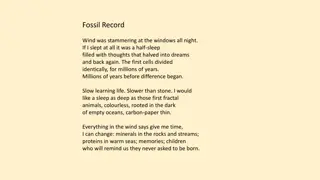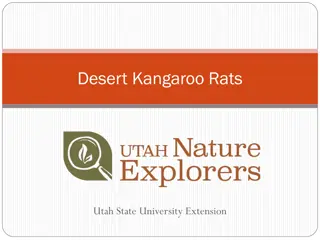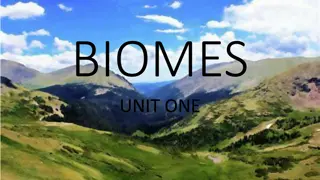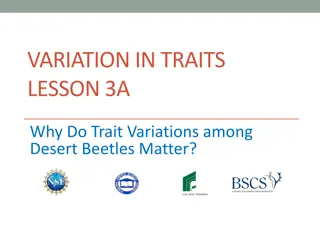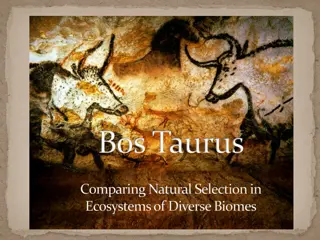Grassland, Tundra, and Desert Biomes: Exploring Earth's Diverse Landscapes
Grassland, tundra, and desert biomes are unique ecosystems shaped by varying levels of rainfall. From the grassy plains of savannas to the harsh conditions of tundras, each biome hosts a diverse array of plants and animals adapted to survive in challenging environments. Discover the distinct characteristics and inhabitants of these biomes as they play a crucial role in the Earth's ecological balance.
Download Presentation

Please find below an Image/Link to download the presentation.
The content on the website is provided AS IS for your information and personal use only. It may not be sold, licensed, or shared on other websites without obtaining consent from the author.If you encounter any issues during the download, it is possible that the publisher has removed the file from their server.
You are allowed to download the files provided on this website for personal or commercial use, subject to the condition that they are used lawfully. All files are the property of their respective owners.
The content on the website is provided AS IS for your information and personal use only. It may not be sold, licensed, or shared on other websites without obtaining consent from the author.
E N D
Presentation Transcript
Chapter 6: Biomes Section 3: Grassland, Tundra, and Desert
Grassland, Desert, and Tundra Biomes In climates that have less rainfall, forest biomes are replaced by savanna, grassland, and chaparral biomes. As even less rain falls in these biomes, they change into desert and tundra biomes. As precipitation decreases in an area, the diversity of the species in the area also decreases. But, the number of individuals of each species present may still be very large.
Savannas Savannas are plains full of grasses and scattered trees and shrubs that are found in tropical and subtropical habitats. Found mainly in regions with a dry climate, such as East Africa and western India. Although savannas receive little precipitation throughout the year, they do have a wet season and a dry season. Many animals are only active during the wet season. Grass fires help to restore nutrients to the soil during the dry season.
Plants of the Savanna Because most of the rain falls during the wet season, plants must be able to survive prolonged periods without water. Some plants have large horizontal root systems to help them survive the dry season. These roots also enable the plant to grow quickly after a fire. The grasses also have coarse vertical leaves that expose less surface area to help conserve water, while some trees shed their leaves. Almost all have thorns for protection from herbivores.
Animals of the Savanna Grazing herbivores, like the elephant, have adopted migratory ways of life, following the rains to areas of new grass and fresh watering holes. Predators often stalk these animals for food. Many savanna animals give birth only during the rainy season, when food is abundant and the young are more likely to survive. Some species of herbivores reduce competition for food by eating vegetation at different heights than other species do.
Temperate Grasslands Temperate grasslands are communities (or biomes) that are dominated by grasses, have few trees, and are characterized by hot summers and cold winters, with rainfall that is intermediate between that of a forest and a desert. Temperate grasslands have the most fertile soil of any biome. Few natural temperate grasslands remain because many have been replaced by grazing areas and farms growing crops such as corn, soybeans, and wheat.
Temperate Grasslands Temperate grasslands are located on the interiors of continents where too little rain falls for trees to grow and include the prairies of North America. Mountains often play a crucial role in maintaining grasslands as rain clouds from the west are blocked. However, rainfall does increase as you move eastward, allowing taller grasses to grow. Heavy precipitation is rare in the grasslands, allowing the hot temperatures in the summer to make the grasslands susceptible to fires.
Plants of Temperate Grasslands The roots system of prairie grasses form dense layers that survive drought and fire allowing the plants to come back from year to year. Few trees survive on the grasslands because of the lack of rainfall, fire, and the constant winds. The amount of rainfall in the area determines the types of plants that will grow in that area with varying root depth and grass height.
Animals of Temperate Grasslands Some grazing animals, such as the bison and pronghorn antelope, have large, flat teeth for chewing the coarse prairie grasses. Other grasslands animals, such as prairie dogs, owls, and badgers, live protected in underground burrows that protect them from predators on the open grasslands.
Threats to Temperate Grasslands Farming and overgrazing have changed the grasslands. Grain crops cannot hold the soil in place as well as native grasses can because the roots of crops are shallow, so soil erosion eventually occurs. Erosion is also caused as the grasses are constantly eaten and trampled. Constant use can change the fruitful grasslands into desert like biomes.
Chaparral Chaparral is a type of temperate woodland biome with vegetation that includes broad leafed evergreen shrubs and is located in areas with hot, dry summers and mild, wet winters. Chaparrals are located in the middle latitudes, about 30 north and south of the equator. Chaparrals are located primarily in coastal areas that have Mediterranean climates.
Plants of the Chaparral Most chaparral plants are low-lying, evergreen shrubs and small trees that tend to grow in dense patches and include chamise, manzanita, scrub oak, and herbs like sage and bay. These plants have small, leathery leaves that contain oils that promote burning, allowing natural fires to destroy competing trees. Chaparral plants are well adapted to fire and can re-sprout from small bits of surviving plant tissue.
Animals of the Chaparral A common adaptation of chaparral animals is camouflage, shape or coloring that allows an animal to blend into its environment. Animals such as quail, lizards, chipmunks, and mule deer have a brownish gray coloring that lets them move through the brush without being noticed.
Threats to the Chaparral Worldwide, the greatest threat to chaparral is human development. Humans tend to develop lands of the chaparral for commercial and residential use because these biomes get a lot of sun, are near the oceans, and have a mild climate year round.
Deserts Deserts are regions that have little or no vegetation, long periods without rain, and extreme temperatures. Although there are hot and cold deserts, one characteristic they both share is the fact that they are the driest places on Earth. Deserts are often located near large mountain ranges because mountains can block the passage of moisture-filled clouds, limiting precipitation.
Plants of the Desert All desert plants have adaptations for obtaining and conserving water, which allows the plants to live in dry, desert conditions. Plants called succulents, such as cactuses, have thick, fleshy stems and leaves that conserve water. Their leaves also have a waxy coating to prevent water loss, while sharp spines on the plant keep animals away. Many plant roots spread out just under the surface to absorb as much rain as possible.
Plants of the Desert Some plants are adapted to survive for long periods of time without water. When conditions are too dry, these plants die and drop their seeds that stay dormant until the next rainfall. Then, new plants quickly germinate, grow, and bloom before the soil becomes dry again. These plants can survive their water content dropping to as low as 30 percent of their mass.
Animals of the Desert Animals of the desert have adapted many different ways to prevent water loss. Reptiles have thick, scaly skin that prevents water loss. Amphibians survive by estivating, or burying themselves in the ground and sleeping through the dry season. Insects are covered with body armor that helps them retain water. In addition, most desert animals are nocturnal, meaning they are active mainly at night or dusk when it is cooler.
Tundra The tundra is a treeless plain that is located in the Arctic or Antarctic and that is characterized by very low winter temperatures, short, cool summers, and vegetation that consists of grasses, lichens, and perennial herbs. Summers are short in the tundra, so only the top few centimeters of soil thaw. Permafrost is the permanently frozen layer of soil or subsoil and can be found in the tundra regions.
Vegetation of the Tundra Mosses and lichens, which can grow without soil, cover vast areas of rocks in the tundra. The soil is thin, so plants have wide shallow roots to help anchor them against the icy winds. Most flowering plants are short, which keeps them out of the wind and helps them absorb heat from the sunlit soil. Woody plants and perennials have evolved dwarf forms that grow flat along the ground.
Animals of the Tundra Millions of migratory birds fly to the tundra to breed in the summer when food is abundant. Caribou migrate throughout the tundra in search of food and water. Hunters such as wolves prey on migratory caribou, deer, and moose. Rodents stay active, but burrow underground to avoid the cold. Other year-round residents, such as arctic foxes, lose their brown summer coat for white fur that camouflages them with the snow.
Threats to the Tundra The tundra is one of the most fragile biomes on the planet. The food chains are relatively simple so they are easily disrupted. Until recently these areas have been undisturbed by humans But oil was located in parts of the tundra, and oil exploration, extraction, and transport has disrupted many tundra habitats. Pollution caused by spills or leaks of oil and other toxic materials may also poison the food and water sources of organisms of the tundra.
